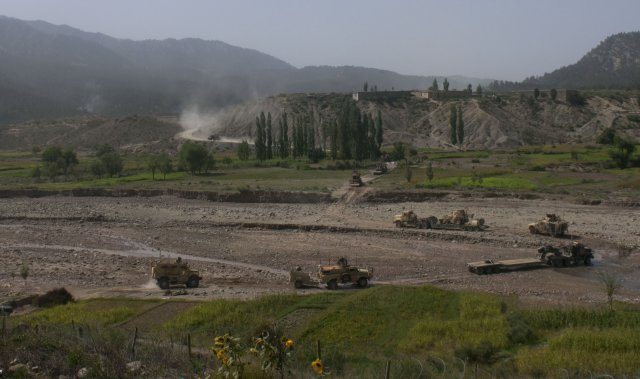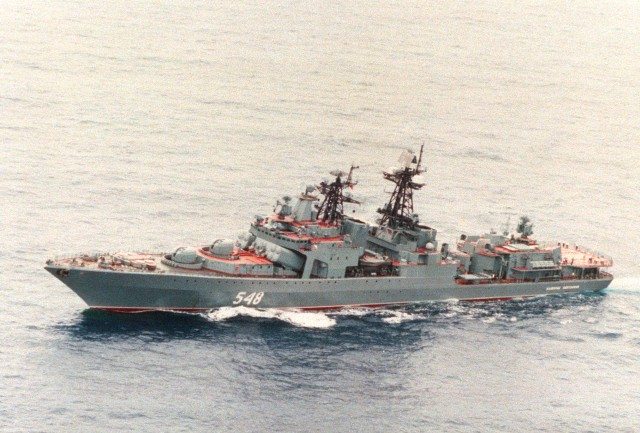The Army would like to see the route through Pakistan available again to get things out of Afghanistan when the time comes, said one Army senior leader.
Lt. Gen. Raymond V. Mason, deputy chief of staff, logistics, Army G-4, spoke March 28 in front of the House Armed Services Committee subcommittee on readiness, to discuss Army materiel reset.
Right now, the Army is using the “northern distribution network”, or NDN, which comes into Afghanistan through countries to the north, such as Turkmenistan, Uzbekistan, and Tajikistan, to get things into the country. But the route is long, and three to four times more expensive than the Pakistan Ground Lines of Communication, or PAKGLOC, to the south. That route is important to the Army’s planning efforts in Afghanistan.
“We need to continue to negotiate and get that back open,” Mason said. “We need both methods to get out of Afghanistan.” The PAKGLOC has been closed since November, the general told lawmakers.
Right now, the Army is using aircraft to get things home. “We fill aircraft as they depart, both Air Force aircraft and commercial aircraft,” Mason said. “We’re using every available aircraft to go back out again.”
As an alternative, Mason said the Army is doing proofs of principle on an idea to use the northern distribution network or NDN to get things out of country, something it can’t do regularly, due to diplomatic reasons.
In partnership with the U.S. Transportation Command, or USTRANSCOM, the Army is experimenting with something Mason called “back haul,” where trucks that bring goods into the country do not leave empty as they have been doing.
“We have several hundred vehicles and containers that are moving back on the NDN working through the diplomatic clearances,” Mason said. The effort is getting assistance from the Department of State, Central Command and USTRANSCOM.
“That’s looking very good,” Mason said. “Once we get that done, I think we’ll be able to get the EXFLOW back out of the NDN.”
Still, he said that will raise the cost for retrograde — moving military equipment out of country and back home. Working on the NDN, he said, means multiple modes of transportation and requires moving equipment between those modes. That increases the costs, he said.
“The PAKGLOC is critical,” he told legislators.
WHAT’S LEFT BEHIND
When the United States left Iraq, military equipment, supplies and material were left behind — sold to the Iraqis or simply given to them because the cost of bringing some things home outweighed their value.
“We in fact did that significantly in Iraq to the tune of about $1 billion,” Mason said.
But in Afghanistan, he said, things will be different.
“We’re not going to have the same opportunity in Afghanistan, we don’t think,” he explained.
Certain equipment can be sold to the Afghans, or donated, Mason said. Old equipment can be divested through the Defense Reutilization and Marketing Service. Some equipment can also be sold to countries near Afghanistan, Mason said.
But, he said, “I think the vast majority of what’s in Afghanistan, because of the conditions there, we probably are going to have to move out of that country.”
Some 50,000 vehicles, for instance, will be leaving the country.
PREVENTIVE MEDICINE FOR EQUIPMENT
Mason told lawmakers the status of equipment coming out of country, it’s “health,” has been affected by the Army’s pre-emptive efforts in theater to maintain equipment on the ground.
“We put significant special repair activities in theater, that has infused health into our vehicles and our equipment coming back,” Mason said. While not all the equipment is as good as it could be, he said, “some of this equipment is actually in better shape than we thought it was going to be.”
That capability included special repair activities in theater, depot-like capability that came from organizations like the Army’s Tank-automotive and Armaments Command and the Aviation and Missile Command. The capability provided by those agencies, he said, “really made a big difference.”
THE MOVERS
What will also be forward in theater are about 2,000 personnel who will be dedicated to retrograde, so that Soldiers who are in Afghanistan to conduct combat operations can continue their efforts there, Mason said.
“We put teams as far forward in the battle space as possible to help those units,” Mason said. “They’re retrograding and we want them to focus on that, [but] their main job is to conduct combat operations. So we’re helping them with that. It was recently approved to put the Central Command materiel retrograde element force of about 2,000 people into theater and they’ll focus purely, every day, on retrograde.”
COST OF RETROGRADE AND RESET
Mason told lawmakers the “worst-case” scenario for the cost of reset is somewhere between $15 and $16 billion. Reset means repairing the equipment that comes home. The actual numbers for that process though, he estimated to be “significantly less than that.”
Force structure changes, and the eventual divestiture of equipment will change what needs to be reset, he said, and that affects cost.
“So we’re not going to reset all the equipment, number one, because there won’t be a requirement for it,” he said. “Number two, some of that equipment will be un-repairable so we won’t repair that particular equipment.”
Mason did say that all helicopters will be kept.
“We need every one of those,” he said. Also, most of the mine-resistant, ambush-protected vehicles, or MRAPs, will be kept.
The real cost of reset from Afghanistan and Iraq will be decided based on what equipment looks like as it leaves theater.
“While we can do some inspection in theater, most of that equipment is out being used every day. So you really don’t know until it gets back to the depot , until you get a full inspection on it.”
Mason told lawmakers that during operations in Iraq and Afghanistan, the Army “rode our equipment hard.” And reset for that equipment is “key and central” to the Army. The peak of reset operations, where most funding would be spent, he estimated, would be around 2015-2016.











